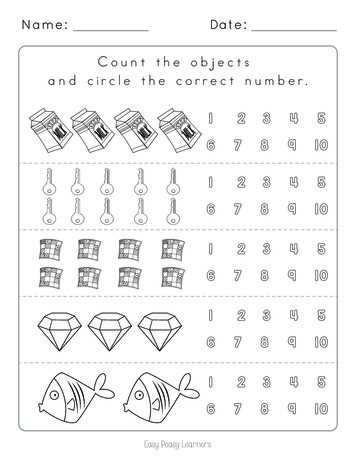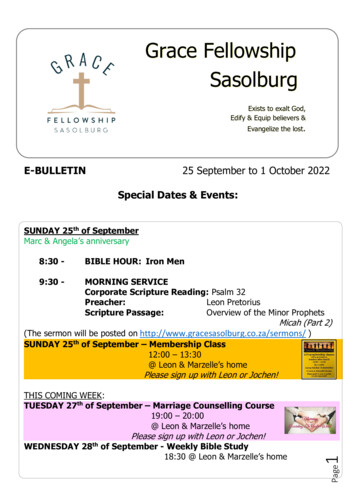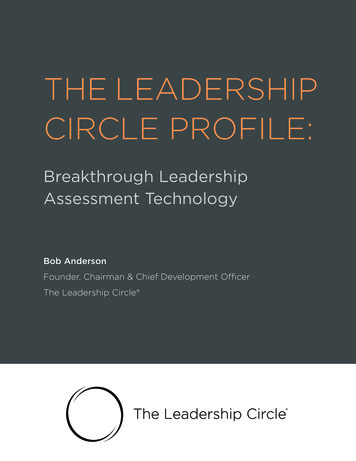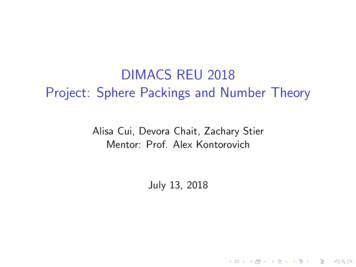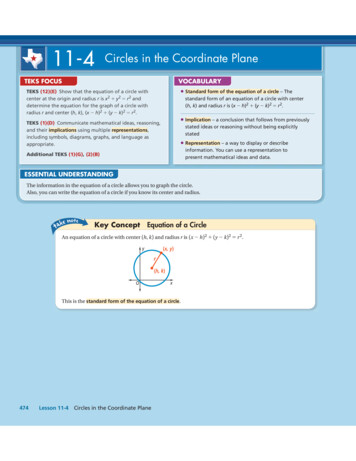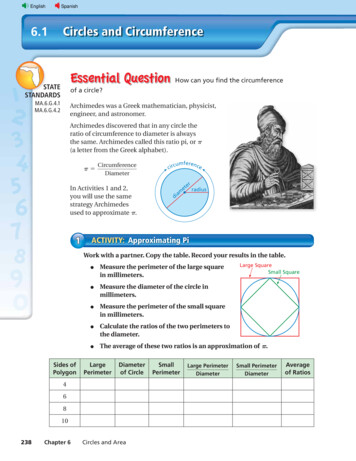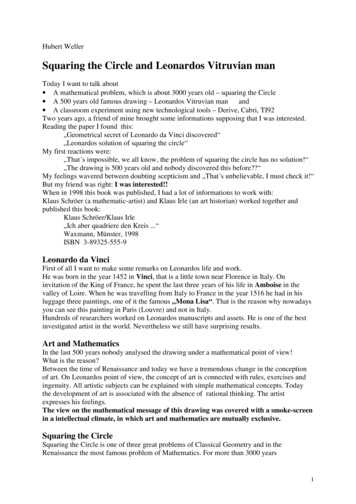
Transcription
Hubert WellerSquaring the Circle and Leonardos Vitruvian manToday I want to talk about A mathematical problem, which is about 3000 years old – squaring the Circle A 500 years old famous drawing – Leonardos Vitruvian man and A classroom experiment using new technological tools – Derive, Cabri, TI92Two years ago, a friend of mine brought some informations supposing that I was interested.Reading the paper I found this:„Geometrical secret of Leonardo da Vinci discovered“„Leonardos solution of squaring the circle“My first reactions were:„That s impossible, we all know, the problem of squaring the circle has no solution!“„The drawing is 500 years old and nobody discovered this before?“My feelings wavered between doubting scepticism and „That s unbelievable, I must check it!“But my friend was right: I was interested!!When in 1998 this book was published, I had a lot of informations to work with:Klaus Schröer (a mathematic-artist) and Klaus Irle (an art historian) worked together andpublished this book:Klaus Schröer/Klaus Irle„Ich aber quadriere den Kreis .“Waxmann, Münster, 1998ISBN 3-89325-555-9Leonardo da VinciFirst of all I want to make some remarks on Leonardos life and work.He was born in the year 1452 in Vinci, that is a little town near Florence in Italy. Oninvitation of the King of France, he spent the last three years of his life in Amboise in thevalley of Loire. When he was travelling from Italy to France in the year 1516 he had in hisluggage three paintings, one of it the famous „Mona Lisa“. That is the reason why nowadaysyou can see this painting in Paris (Louvre) and not in Italy.Hundreds of researchers worked on Leonardos manuscripts and assets. He is one of the bestinvestigated artist in the world. Nevertheless we still have surprising results.Art and MathematicsIn the last 500 years nobody analysed the drawing under a mathematical point of view!What is the reason?Between the time of Renaissance and today we have a tremendous change in the conceptionof art. On Leonardos point of view, the concept of art is connected with rules, exercises andingenuity. All artistic subjects can be explained with simple mathematical concepts. Todaythe development of art is associated with the absence of rational thinking. The artistexpresses his feelings.The view on the mathematical message of this drawing was covered with a smoke-screenin a intellectual climate, in which art and mathematics are mutually exclusive.Squaring the CircleSquaring the Circle is one of three great problems of Classical Geometry and in theRenaissance the most famous problem of Mathematics. For more than 3000 years1
mathematicans have worked on the problem of constructing a square equal in area to that of agiven circle.Whether or not it is possible depends, of course, on what tools you allow yourself. Platoinsisted that the problem be solved with straightedge and compass only.Remark: When Lindemann proved in 1882 that Pi is transcedental he effectively proved thatthe solution is impossible in a finite number of constructions.Leonardo expressed several times his intention to write a book about Geometry. In this bookhe intended to describe various procedures to solve the problem of squaring the circle. Butthis book was never finished!!Vitruvian man(Vitruv, Roman architect, wrote 30 B.C. the book „De Architectura“, which influencedarchitecture in the Renaissance)In the Internet you can find a lot of Web-Sites withLeonardos drawing, but nearly half of the pictures arereversed. Possibly the authors didn t realize thatLeonardo wrote all his texts in mirror-writing!!In the classroom we made exact measurements andcompared this with Leonardos text.Comparing areas of the square and the circle (center isthe man s navel) you can easily see a difference.Circle: 176.72 cm²Square: 153.51 cm²Schröer and Irle focussed there eyes on the rotation ofthe arms. The center of the rotation is marked in thedrawing. (Ratio of length of the arms and length of thesquare is fak 0.436)First of all they asked for a circle possibly equal in areawith the given square. So they realizied that the circleyou can easily construct has nearly the same area as thesquare!All research workers didn t pay attention to thiscircle !!Circle: 153.94 cm²But what s about a second square equal in area with thelarger circle? (Leonardos drawing contains thecharacteristic of a so called emblem, which were usedin the 16th and 17th century)Schröer and Irle found the missing link:Connect the corner of the square with the center of thecircle and you can construct a larger square (nearly)equal in area to the circle.Square: 176.89 cm²2
The real surprise is the procedure for a construction, defined in this way:We start with a square and a Connect upper intersectioncircle intersecting thepoints, multiply length of thesquare’s sidessquare with 0.436 and we getmidpoint of the rotation ofthe armsPerpendicular bisector yieldscenter point of the largercircleConstruct the larger circleIntersection point of armrotation with upper side ofthe square is marked.Connecting the edge of thesquare and center point of thelarger circle and you candraw intersection point withthe larger circleSecond square is drawn3
First CalculationsIn the classroom we started with an example:( a1 10 and r1 5.4 )(Geometrical construction and algebraiccalculations parallel) For the geometrical constructions (by hand)we used straightedge and compass. I think,it is necessary to use the fingers for at leastone example!!For the calculations we used Derive.You need equation of a straight line andequation of a circle in this form:( x – xm )² ( y – ym )² r²The role of the CAS:We use Derive to solve 4 equations but the process must be controlled by the students.Questions Does the sequence of ratios of areas (circle – square ) converge?What s the limit of this sequence?What s the effect of other dimensions of the initial pair (circle – square)?Does the sequence converge, if you use different factors ( fak 0.436 ) ?What s the effect of the factor on the limit of the sequence?4
Geometrical Iteration with CabriOne of the most powerful tools is the application of macros.We use for simplification fak: 0.5Iterations with DeriveWe cannot be satisfied with these results. Our next calculation (algebraic-analytical methods)uses the ITERATES-Function of Derive.Syntax of the ITERATES-Function:ITERATES( Operation , Variable , Initial Object , Number of Iterations )Informations in a row: Length of initial square a1 Radius of initial circle r1 (Calculated) length of final square a2 (Calculated) Radius of final circle r2 Area of final circle Area of final square Ratio of this areas in percent5
Operation (generating a row by the preceeding row) :Take the 3rd and 4th value in the following row as initial objects!!Different initial objects:fak: 0.436a1: 10r1: 5.2r1: 5.6r1: 6.0r1: 8.0fak: 0.45fak: 0.46fak: 0.5Different factors:fak: 0.356
Summing upThe special attraction is to work at different levels: Historical aspects Geometric-constructiv work with compass and straightedge Calculations of intersection-points (line – circle), lengths and ratios Constructions with a DGS Iterations with a CASThe real fascination is not answering the question for the problem ofsquaring the circle, but the convergence of that sequence generated byLeonardo s procedure!!Thats the real secret of this drawing!!Student reactions„ Most important for me was, that mathematics is not only a boring manipulation of terms ,but can be an exiciting puzzle.“„ I liked the variation“„Most important for me was to be able to control the computer-applications for the solutions“„I liked to discover a little bit of Math-history“„The actuallity!“7
Squaring the Circle is one of three great problems of Classical Geometry and in the Renaissance the most famous problem of Mathematics. For more than 3000 years . larger circle and you can draw intersection point with the larger circle Second square is drawn. 4 First Calculations In the classroom we started with an example:


